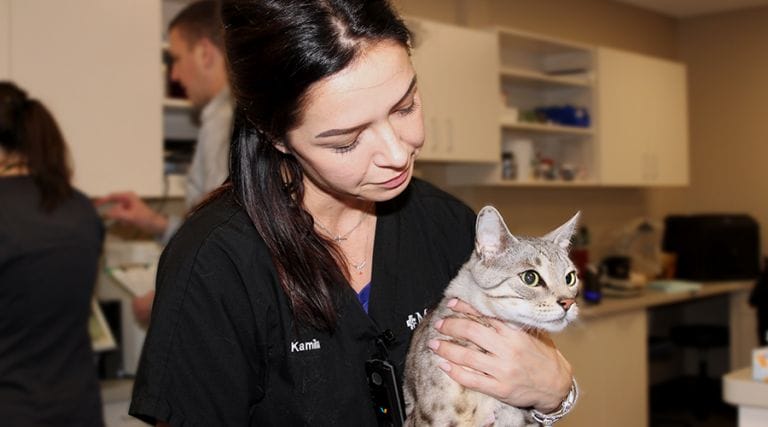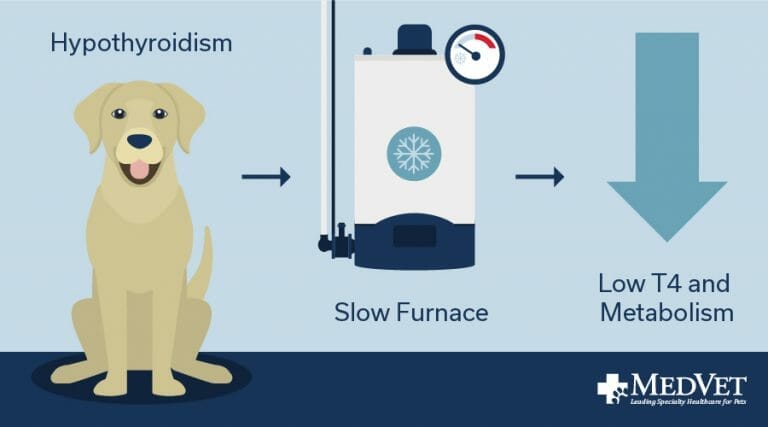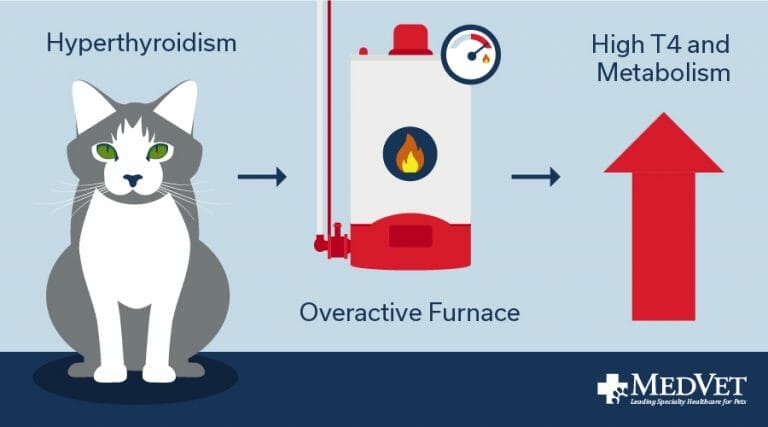
Sometimes weight can be like a roller coaster. You gain some. Then you lose some. Then maybe you gain a few more pounds back. It’s true for people, and it can be true for pets. But did you know that weight swings like this in your pet may be a sign of thyroid disorders?
What is the thyroid?
The thyroid gland is an organ in the neck that produces a hormone called “T4,” and it plays an important role in the endocrine or hormonal system. It regulates metabolism, or how active your cells are in utilizing energy, as well as other body functions. It also ramps up when you are cold and slows down when you get hot. Think of it as the “furnace” of the body.
Your pet’s thyroid gland can become diseased which can cause their “furnace” to act up! In some cases, your pet can have an underactive thyroid (hypothyroidism) which means their “furnace” runs too little and doesn’t produce enough of the T4 hormone. This creates a slower metabolism and is more often seen in dogs. On the other end of the spectrum is an overactive thyroid (hyperthyroidism). In this case, their “furnace” runs too much, causing levels of the T4 hormone that are too high. This speeds up metabolism and is more common in cats.

Canine Hypothyroidism – thyroid disorders in dogs
Hypothyroidism occurs when the thyroid gland is not as active as it should be which leads to low levels of the T4 hormone in the body. In this case, the “furnace” isn’t running enough. It can develop in your dog without you even realizing it. By the time it is diagnosed, your dog could have lost up to 75% of their thyroid tissue.

Symptoms of underactive thyroid include:
- Weight gain
- Cold intolerance
- Lethargy or weakness
- Exercise intolerance
- Skin changes such as skin darkening, and skin infections
- Poor-quality hair coat
- Hair loss (often around the flanks, thighs, neck, and tail)
- Slow hair regrowth of hair or hair that won’t regrow after it has been clipped
- Some dogs will also experience anemia (low red blood cells) or high cholesterol levels
Causes:
There’s not always a clear cause of canine hypothyroidism. It can be caused by your dog’s immune system attacking their thyroid gland, or it can be from atrophy of the thyroid tissue over time. The disease can also be hereditary, meaning dogs who are genetically related have a higher risk for developing the disease. Although it can occur in any dog, there are certain breeds that are more likely develop the condition. These include the English Setter, Golden Retriever, Rhodesian Ridgeback, Cocker Spaniel, Boxer, Doberman Pinscher, Great Dane, Beagle, Borzoi, and Giant Schnauzer. The average age for a dog to develop the disease is around 7. However, it can be seen in dogs anywhere from 6 months to 15 years old.
Diagnosis and Treatment:
To diagnose a thyroid disorder, your veterinarian will do a simple blood test to check for the levels of the thyroid hormone (T4). In the case of hypothyroidism, your pet’s thyroid isn’t producing enough T4, so treatment is focused on increasing the hormone in their body. Medication involves a synthetic supplement of T4.
Dogs usually respond well to treatment. Dullness and lethargy are the first signs to improve, sometimes within days. Any changes to their skin changes can take a bit longer, but often are back to normal in two to three months. If your dog has gained weight, rehabilitation and treadmill therapy can help them once they are on the correct medication.
Feline Hyperthyroidism – thyroid disorders in cats
Hyperthyroidism is caused by an overactive thyroid. In this case, the “furnace” is running too much, which means the thyroid produces too much of the T4 hormone. It is the most common endocrine disease in cats, and by some estimates, nearly 10% of older cats develop the disease.

Symptoms of overactive thyroid include:
- Weight loss
- Increased appetite
- Hyperactivity
- Vomiting, diarrhea, urinating more
- Excessive thirst/drinking more
- Poor grooming resulting in an unkept appearance
- Behavioral changes like stress intolerance, painting, anxiousness, or irritability
- Some cats may even feel lethargic and depressed, which veterinarians call “apathetic hyperthyroidism”
- Increased liver enzymes.
Causes:
Hyperthyroidism in cats is typically caused by a benign (non-cancerous) tumor in the thyroid gland that is overproducing the T4 hormone. The disease usually impacts middle aged to older cats, with an average age of 12.5 years.
Diagnosis and Treatment:
If the disease is left untreated, it can result in severe metabolic compromise, heart disease, or even death. Diagnosing hyperthyroidism involves a simple blood test looking for increased levels of the T4 hormone. Because the disease is so common in cats, the test may be included in routine, yearly lab work even if your cat isn’t showing any symptoms.
Because the thyroid gland is overactive causing too much T4, treatment is focused on decreasing the hormone production.
This can be done in a variety of ways:
- Medication: Methimazole is a pill given orally that is very effective at treating the disease, but has its own set of challenges. It can be difficult to give some cats, and it does not cure the disease, so your cat would have to take it for the rest of their life. Although a good amount of cats have no side effects to the medication, there are many potential side effects. The most common are not life-threatening but can include nausea, vomiting, lethargy, diarrhea, and facial rashes or lesions from your cat scratching. In some cats, there can be severe, life-threatening side effects such as low white blood cells or platelets, liver failure, or bleeding.
- Diet: Because iodine is required to form thyroid hormones, sometimes a low-iodine diet such as Hill’s y/d can be effective at suppressing hormone production because iodine is required to form thyroid hormones. This does not cure the disease, and not all cats respond well to the specialized diet, even though their thyroid levels improve.
- Surgery: You can opt to have the thyroid gland removed. Although this does cure the disease, there are downsides like the potential side effects of low calcium, the need for anesthesia, and the risk of damaging other structures in the neck.
- Radioiodine Therapy: This is widely considered the best treatment option since it does cure the disease and has fewer side effects than surgery. Cats are injected with a radioactive iodine compound called i-131. Since the thyroid is the only place in the body that uses iodine, the compound accumulates in the abnormal thyroid tissue and emits beta particle radiation to the thyroid gland nodule without affecting the rest of the body.